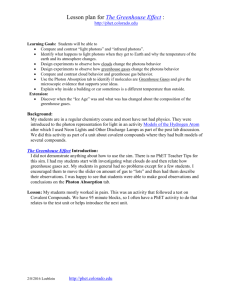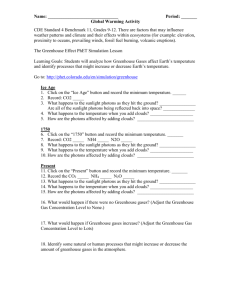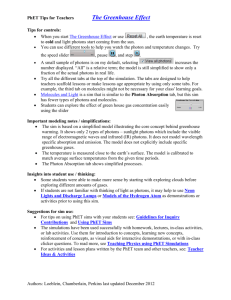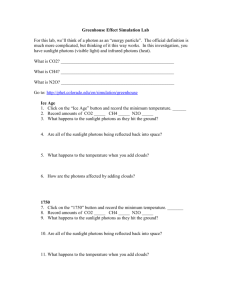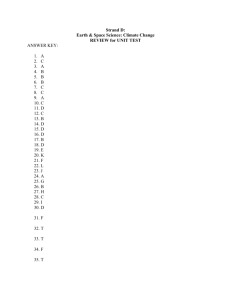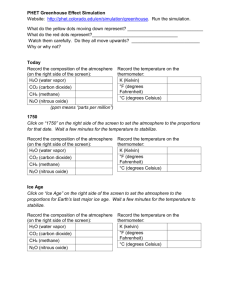The Greenhouse Effect
advertisement
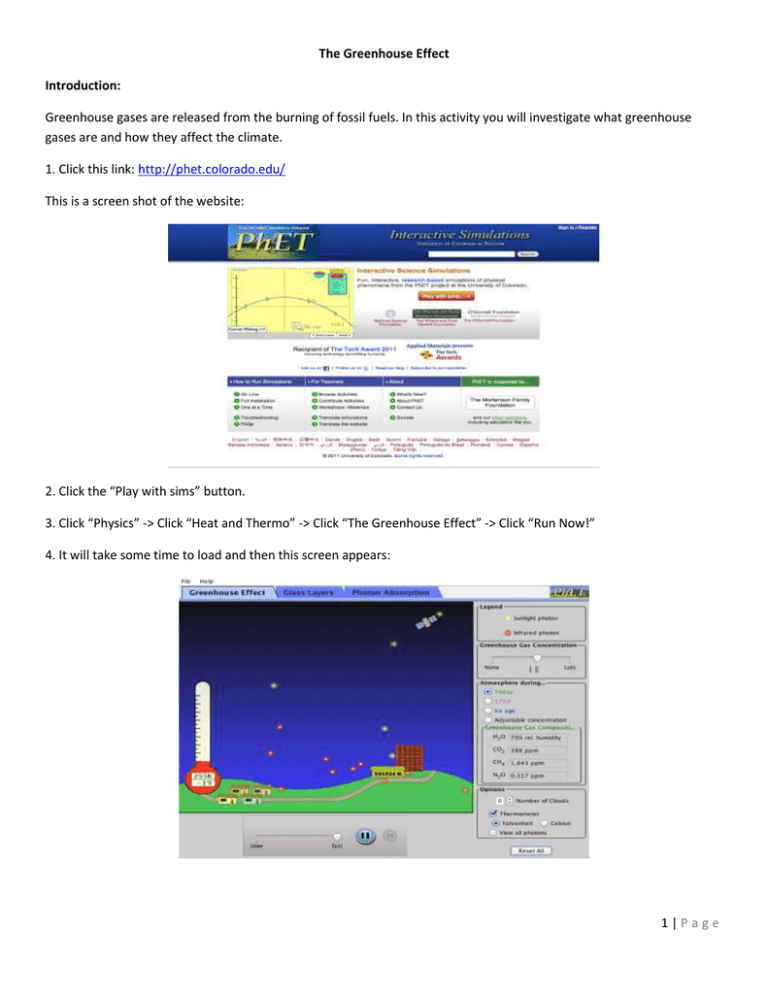
The Greenhouse Effect Introduction: Greenhouse gases are released from the burning of fossil fuels. In this activity you will investigate what greenhouse gases are and how they affect the climate. 1. Click this link: http://phet.colorado.edu/ This is a screen shot of the website: 2. Click the “Play with sims” button. 3. Click “Physics” -> Click “Heat and Thermo” -> Click “The Greenhouse Effect” -> Click “Run Now!” 4. It will take some time to load and then this screen appears: 1|Page Exploration Phase 1. Click the “Greenhouse Effect” tab on the sim. 2. First, just look at the sim and observe what is happening (notice the amount of sunlight photons and infrared photons moving around). On the bottom of the sim, you can slow it down to observe better. 3. On the right side of the sim are different tools that you can adjust. Try increasing and decreasing the number of clouds or the atmosphere. 4. Freely explore all of the different tools. Questions (COMPLETE SENTENCES): 1. What was the average temperature (°F) during the “Ice Age?” 2. What was the average temperature (°F) in “1750?” 3. What is the average temperature (°F) “Today?” 4. Both the yellow and red stars represent forms of energy in the form of photons: the yellow are visible light, the red are heat. When looking at “Today” what do you notice, more infrared (heat) photons or sunlight photons? Explanation Phase Aim: What effect do greenhouse gases have on our climate? Click on the tab, “Photon Absorption.” The screen will look like this: 2|Page Here are some concepts: A greenhouse is a glass house that absorbs heat, light, and energy from the sun and keeps the plants and air warm. None of this warm air can escape because it is trapped in the glass walls. Photons are particles of light or electromagnetic energy. The sunlight photons (yellow) represent energy radiating from the sun, and the infrared photons (red) represent the heat/energy that is released from the earth and goes back out to the atmosphere. Use this sim to find out which gases are greenhouse gases. 1. Click “Infrared Photon,” and speed the release of the photons up on the tool on the left. Then click each of the gases on the right (except for build atmosphere) and observe for 10 seconds each. Complete the “Infrared Photons” column in the table below by indicating which gases absorb the infrared photons. 2. Click “Visible Photon,” then on the left, click each gas and observe each for 10 seconds again. Complete the “Visible Photons” column in the table below by indicating which gases absorb the visible photons. Infrared Photons Visible Photons CH4 (methane) CO2 (carbon dioxide) H2O (water vapor) N2 (nitrogen) O2 (oxygen) 3. Based on what the definition of a greenhouse and assuming that the glass house is our earth, which gases (3) are greenhouse gases? Which gases (2) do NOT contribute to the greenhouse effect? 3|Page Click on the tab, “Glass Layers.” The screen will look like this: Use the sim and fill in the blanks of the following table: Number of Glass Panes Average Temp (F) 0 1 2 3 1. What are the patterns you notice from the table? 2. As you add more glass panes, what is happening to the transmission of sunlight photons to the Earth? What is happening to the absorption of the infrared photons? 4|Page Application Phase Now, click on the first tab, “Greenhouse Effect” again: . Greenhouse Gas Concentration Average Temperature (F) Amount of Greenhouse Gas CO2 (ppm) None During Ice Age In 1750 Today 1. Based on the rate of your table, what do you think the average temperature will be in 100 years? The amount of CO2? 2. What difference would there be on Earth if there were no greenhouse gases and if many gases were trapped? 5|Page Click, “Reset All” on the bottom right, and add 1 cloud every 20 seconds. Before adding a cloud, observe what is happening to the sunlight and infrared photons. Number of Clouds Description of Sunlight Photons Description of Infrared Photons 0 1 2 3 3. Clouds are made of water vapor. Are they keeping our earth cooler or warmer? Conclusion: How are greenhouse gases affecting our climate? Where are they coming from? What can we do to possibly slow down or stop this rate of global warming? Answer these questions THOROUGHLY (7-10 sentences) using the space below. 6|Page
